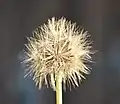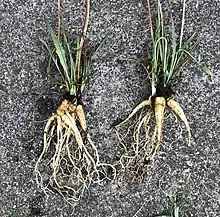Microseris scapigera
Microseris scapigera is a yellow-flowered daisy, a perennial herb, found in New Zealand and Australia.[2][3] It is the only New Zealand species of Microseris, and one of three Australian species along with Microseris lanceolata and Microseris walteri. It is classified in a group of plants, the tribe Cichorieae, that includes chicory and dandelion.
| Microseris scapigera | |
|---|---|
 | |
| Scientific classification | |
| Kingdom: | Plantae |
| Clade: | Tracheophytes |
| Clade: | Angiosperms |
| Clade: | Eudicots |
| Clade: | Asterids |
| Order: | Asterales |
| Family: | Asteraceae |
| Tribe: | Cichorieae |
| Genus: | Microseris |
| Species: | M. scapigera |
| Binomial name | |
| Microseris scapigera | |
| Synonyms[1] | |
| |
The murnong or "yam daisy" has been referred to M. scapigera, M. lanceolata, or M. forsteri, but is now classified as M. walteri.
Now rare and vulnerable due to loss of habitat.[4]
Taxonomy and nomenclature
Joseph Banks and Daniel Solander collected specimens of the plant in New Zealand in 1769 or 1770, but Solander's manuscripts were never published. The locality of their collection is stated by later authors as either the Bay of Islands or Queen Charlotte Sound (Totara nui). Georg Forster (1786) listed the name "Scorzonera scapigera S." in an appendix without description.[5] Allan Cunningham gave a brief description in 1839, mentioning Solander's manuscripts and Banks' specimens plus another specimen collected by his brother Richard.[6]
Joseph Dalton Hooker[7] thought that the species didn't belong well in Scorzonera: he had proposed a subgenus, then placed it in Microseris, beside M. pygmæa of Chile.[8] He gave the name as Microceris Forsteri in 1852,[9] however Cunningham's description with the epithet scapigera takes precedence. Carl Heinrich Schultz 'Bipontinus' published the combination Microseris scapigera in 1866, listing Hooker's M. forsteri and Forster's S. scapigera as synonyms.[10] Neither Hooker nor Schultz referenced Cunningham's description; in 2015 Sneddon designated a lectotype for Schultz' name.[11]
Some authorities have grouped M. scapigera with the other Australian forms into single species under the name M. lancifolia, for example A census of the vascular plants of Victoria, Edition 3. (1990) and Australian Plant Census (2011).[12] Sneddon (2015), in Flora of Australia maintained two separate species, and the Melbourne Herbarium has supported both plus a third unnamed species since the early 1990s.[12] The third species was formally described by Neville Walsh in 2016, matching herbarium specimens were identified, and the name M. walteri was selected.[12]
Conversely, M. scapigera has earlier been "misapplied to" M. lanceolata in the Flora of South Australia (1st and 2nd editions, 1929 and 1957) and The Student's Flora of Tasmania (1963).[13]
Botanical naming
For more than 30 years Murnong was named as Microseris sp. or Microseris lanceolata or Microseris scapigera. Royal Botanic Gardens Victoria botanist Neville Walsh clarified the botanical name of Microseris walteri in 2016 and defined the differences in the three species in the table below.[14]
| Feature | M. walteri | M. lanceolata | M. scapigera |
|---|---|---|---|
| Roots | single fleshy root expanding to a solitary, napiform to narrow-ellipsoid or narrow-ovoid, annually replaced tuber | several fleshy roots, cylindrical to long-tapered, branching just below ground-level | several cylindrical or long-tapered, usually branched shortly below leaves |
| Fruit (Capsela) | usually less than 7mm long | usually less than 7mm long | mostly 7–10 mm long |
| Pappus bristles | c. 10 mm long, 0.5–1.3mm wide at base | 10–20 mm long, c. 0.3–0.5 mm wide at base | 30–66 mm long |
| Joined petals (Ligule) | usually more than 15mm long | usually more than 15mm long | up to 12mm long |
| Origin | lowlands of temperate southern WA, SA, NSW, ACT, Victoria and Tasmania | rarely on basalt soils; alpine and subalpine NSW, ACT and Victoria | mostly from basalt plains of western Victoria and elevated sites in Tasmania |
| Taste of roots | sweet-tasting, both raw and cooked | bitter, slightly fibrous and not particularly palatable | slightly fibrous, and slightly, but tolerably bitter |
Gallery
 Microseris scapigera flower measurement
Microseris scapigera flower measurement Seed clock
Seed clock Multiple fleshy roots
Multiple fleshy roots Leaves and flowers
Leaves and flowers Seed comparison, from left to right: Microseris scapigera, Microseris walteri and Microseris lanceolata
Seed comparison, from left to right: Microseris scapigera, Microseris walteri and Microseris lanceolata
Uses
Plants of Microseris scapigera sensu have no tubers, but roots that are "fleshy, only slightly fibrous, and slightly, but tolerably bitter when eaten raw".[12] Indigenous Australians may have eaten this plant also, but historical sources describe murnong as a sweet tuber. The bitterness in Microseris scapigera roots can be removed by blanching the roots in boiling water for 5 minutes, before consumption or further cooking.
Aboriginal populations in southeastern Australia relied on tubers of the daisy yam as a staple,[15] and actively cultivated it.[16] It is known as ngampa in the Thura-Yura languages.[17]
References
- The Plant List: A Working List of All Plant Species, retrieved 1 July 2016
- Flora Committee (2010). Breitwieser, I.; Brownsey, P.; Ford, K.; Glenny, D.; Heenan, P.; Wilton, A. (eds.). "Microseris scapigera (Sol. ex A.Cunn.) Sch.Bip". Flora of New Zealand. Online Edition. Accessed at www.nzflora.info. Retrieved 4 March 2013.
- Lunt, Ian (January 2016). "A Transient Soil Seed Bank for the Yam-daisy Microseris scapigera.". The Victorian Naturalist. 113 (1): 16–19. Retrieved 3 July 2018.
- "Flora of Victoria". vicflora.rbg.vic.gov.au. Retrieved 26 June 2020.
- Forster, Georg (1786). Florulae Insularum Australium Prodromus (in Latin). Göttingen: Joann. Christian Dietrich. p. 91. Species 534.
- Cunningham, Allan (1839). "Florae insularum Novae Zelandiae precursor". Annals of Natural History. 2 (8): 125.
1. SCORZONERA, L. DC. / 430. S. ? scapigera (Sol. MSS.) foliis lanceolatis retrorso-dentatis integerrimisve, caulibus gracilibus, scapo unifloro. Forst. Prodr. n. 534, absque descipt. / New Zealand (Northern Island). — 1769, Sir Jos. Banks. Among fern, on the hills, Bay of Islands. — 1834, R. Cunningham. / Anne vere species hujus generis ?
- Known as "Hooker filius" to distinguish him from his father, and abbreviated as "Hook. fil." or "Hook.f.".
- Raoul had applied the name of Chilean Microseris pygmæa (Hook. et Arn.) DC to a New Zealand species, presumably this one. (Raoul Choix des Plantes, p. 45; de Candolle Prodromus pp. 88–89; Hooker & Arnott "Contrib. Flora S.Am. – Compositæ" Comp. Bot. Mag. v. 1 p. 30.)
- Hooker, Joseph Dalton (1852). The botany of the Antarctic voyage of H.M. discovery ships Erebus and Terror in the Years 1839-1843: under the command of Captain Sir James Clark Ross. II. Flora Novae-Zelandiae. London: Reeve Brothers. pp. 150–151.
In the ' London Journal of Botany' I proposed making this plant a subgenus of Scorzonera, to which it had been referred, having failed to reduce it to any genus of this difficult tribe described in De Candolle ; it is, however, truly congeneric with the Microseris of Chili, as rightly determined by M. Raoul, but the species is quite a different one.
- Schultz, C. H. 'Bipontinus' (1866). "Beitrag zum Systeme der Cichoriaceen" [Contribution to the systematics of the Cichoriaceae]. Jahresbericht der Pollichia (in German and Latin). 22–24: 296–322. Microseris longifolia and M. scapigera are listed on page 310 in Latin.
- APNI citation 5371511 "Nova Zelandia [New Zealand]. near Totara nui [Queen Charlotte Sound], 1769, Banks and Solander; lecto: (here chosen): BM; isolecto: WELT."
- Walsh, Neville (2016). "A name for Murnong (Microseris: Asteraceae: Cichorioideae)" (PDF). Muelleria. 34: 63–67. Retrieved 4 October 2020.
- "Name 73429 (Microseris scapigera)". Australian Plant Names Index. Retrieved 5 October 2020.
- Walsh, Neville (2016). "A name for Murnong (Microseris: Asteraceae: Cichorioideae)" (PDF). Muelleria. 34.
- Beth Gott, ‘Murnong — Microseris scapigera: a study of a staple food of Victorian Aborigines’, Australian Aboriginal Studies, no. 2, 1983, pp. 12, 14.
- Pascoe, Bruce (2018), Dark Emu : aboriginal Australia and the birth of agriculture, Magabala Books, ISBN 978-1-925768-95-4
- Simpson, Jane and Luise Hercus. 2004. Thura-Yura as a Subgroup. In Claire Bowern and Harold Koch (eds.), Australian Languages: Classification and the Comparative Method, 179-206, 580-645. Amsterdam: John Benjamins.
External links
- Herbarium specimens: WELT SP063840 collected by Banks & Solander, "prope Totaranui" NZ, 1770; Kew K000796796 G. Forster, New Zealand; Kew K000796798 R.C. Gunn, Tasmania, 1844.
- Illustrations: Sydney Parkinson 1895 (print, engraving) .